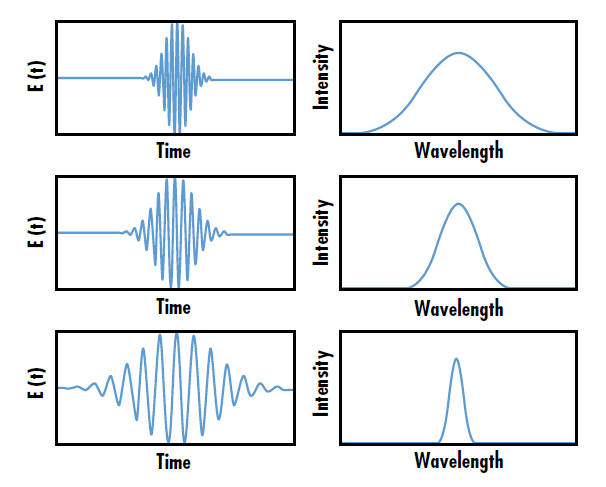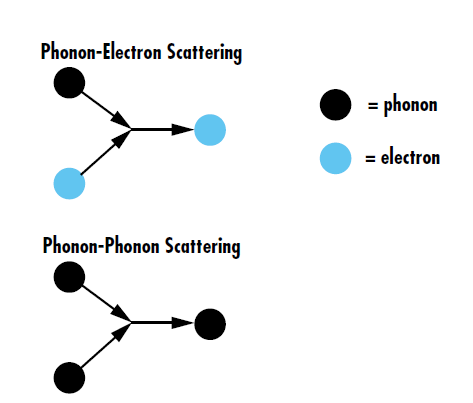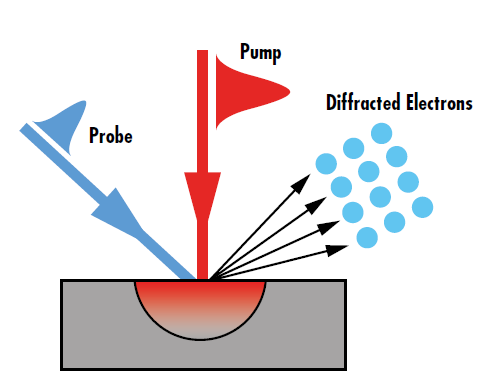超快雷射的 LDT
雷射資源指南第14.8。
超快雷射為鎖定模式的脈衝雷射,能夠發射飛秒或皮秒的極短脈衝並具備高峰值功率。由於傅立葉限制,也就是能量時間不確定性,較短的臨時脈衝長度會對應寬廣的波長光譜範圍,因此相較於較長脈衝,超快脈衝的波長頻寬更寬廣 (圖 1)。超快雷射有利於各式各樣的應用,其中包括高強度物理、飛秒材料加工及雷射光譜儀。1

圖 1: 超快雷射脈衝的波長頻寬,與每脈衝的時間長度成逆向關係
近年來,超快雷射誘發損傷已成為熱門研究主題,因為超快雷射的極短脈衝期,會讓超快雷射與光學鍍膜及元件的互動方式,和其他雷射不同。一般來說,暴露於超快雷射後,薄膜鍍膜會因為不平衡的能量傳遞產生熱能。基態電子吸收入射光子能量,結果在幾飛秒內佔用受激能態。這些“ 熱 ”電子之後會透過皮秒時間標度的聲子電子及聲子聲子散射,鬆弛回到其基態,讓能量重新分佈。2, 3 聲子電子散射以電子波函式描述晶格振動引起的畸變,而聲子聲子散射則描述晶格振動在晶格誘發的其他振動 (圖 2)。

圖 2: 聲子電子散射是指晶格振動與電子之間的能量傳遞,重新導向晶格內部的電子。另一方面,聲子聲子散射是指多次晶格振動之間的互動,以產生新聲子
Since the Fermi distribution of electrons is much faster than the electron lattice redistribution, the thin film can be described as a composition of two interacting subsystems: electrons and phonons.4 Knowing the temperature rise caused by ultrafast excitation is critical to understanding LIDT for ultrafast lasers. The hot carrier relaxation dynamics can be calculated theoretically and experimentally verified using ultrafast pump-probe spectroscopy, which measures the changes in the optical properties of the test optic as a function of time.5, 6
The electron and lattice thermal behavior under ultrafast laser excitation can be described by using a two temperature model assuming that the electron and lattice subsystems independently and spontaneously reach equilibrium. The coupled heat capacity equations are used to determine the theoretical temperature rise from ultrafast excitation and are given by:7
- Ce and Cl are the heat capacities for the electron and lattice subsystems
- Te and Tl are the electron and the lattice temperatures
- ke is the electron thermal conductivity
- S is a heating term introduced by the ultrafast laser pulse dependent on time (t) and space (z)
- G is the electron lattice coupling constant given by:
- me is the effective electron mass
- ne is the electron number density
- cs is the speed of sound in the bulk material described as the square root of the ratio of the bulk modulus over the density ρm
- τ(Te) is the electron relaxation time
Equation 1, Equation 2, and Equation 3 are used to provide Tl and Te as a function of time. 圖 3 shows the theoretical Tl and Te calculated for a 0.2 J/cm2 10fs ultrafast laser pulse centered at 800nm with a beam diameter of 120μm illuminating a 200nm thick gold nanofilm suspended on a copper substrate. The thickness of the gold nanofilm is much larger than the optical and electron penetration depth into the nanofilm.

圖 3: Time-dependent electron (red) and lattice (blue) temperature rise following the ultrafast laser excitation of a 0.2 J/cm2 10fs ultrafast laser pulse centered at 800nm. The heating of the gold nanofilm due to the rise of lattice temperature leads to initiation of laser-induced damage
The electron temperature quickly reaches extremely high temperatures (13,000K). Electron-lattice equilibration processes then lead to an increase in the lattice temperature (Tl), which reaches values of around 1,300K. Tl is on the same order of the melting temperature of gold (1,337K); this relatively weak ultrafast pulse with a fluence of only 0.2 J/cm2 caused the lattice to reach the melting point of gold.
The nonequilibrium system dissipates its energy through electron-phonon and phonon-phonon scattering and a delayed energy transfer from the gold nanofilm to the surrounding copper substrate provides an additional energy dissipation channel. The rise in the lattice temperature reaches remarkably high temperatures, which may lead to laser-induced damage in the coating film. Understanding the ultrafast rethermalization following laser excitation is essential for the design and optimization of optical coatings for ultrafast laser applications.
The theoretical impact of ultrafast pulses can be experimentally verified through ultrafast pump-probe spectroscopy such as ultrafast electron diffraction. An ultrafast pump beam is used to excite the test sample, while a lower-power probe beam monitors the changes in the intensity of electrons diffracted from the sample caused by non-equilibrium state (圖 4). The change in the electron diffraction intensity as a function of the time delay between the arrival of the pulses in the pump and probe beams reveals the electron-lattice dynamics.8 Such dynamics show the relaxation pathways of the excited electrons that lead to the nanofilm heating.

圖 4: The diffraction intensity change observed in pump-probe spectroscopy directly relates to the non-equilibrium energy transport caused by ultrafast laser excitation
The diffraction intensity change caused by the ultrafast laser is governed by the Debye-Waller effect and is given by:
- I(t) is the diffraction intensity at time t
- I0 is the initial intensity
- T0 is the initial temperature
- u2 (T) is the atomic mean square displacement given by:
- ħ is the reduced Planck’s constant, or Planck’s constant divided by 2π
- m is the effective mass of the unit cell
- kB is Boltzmann’s constant
- θD is the Debye temperature
Equation 4 and Equation 5 display the change in the diffracted intensity following laser excitation at different pump-probe time delays. The diffraction intensity change will also be different whether the probe and pump beams are illuminating the coated surface of the optic or the coating-substrate interface (圖 5). The system’s delay time for reaching equilibrium temperature after ultrafast excitation is much longer than the ultrafast pulse duration. The heating of the nanofilm takes place at a picosecond time scale and arises from the equilibration of the excited electron following ultrafast laser excitation.

圖 5: Diffraction intensity change due to electron-phonon and phonon-phonon scattering following ultrafast excitation in a gold nanofilm (blue), as well as diffraction intensity change at the gold-copper interface from energy transfer from the gold nanofilm to the copper substrate (red)
Highly-Dispersive Mirrors from Edmund Optics®

VIEW NOW
Webinar Recording: Ultrafast Optics: Challenges and Solutions

WATCH NOW
參考資料
- Mao, S. S. et al., “Dynamics of Femtosecond Laser Interactions with Dielectrics.” Appl. Phys. A 2004, 79, 1695.
- Jiang, L., and H. l. Tsai. “Energy Transport and Material Removal in Wide Bandgap Materials by a Femtosecond Laser Pulse.” International Journal of Heat and Mass Transfer, vol. 48, no. 3-4, 2005, pp. 487–499., doi:10.1016/j.ijheatmasstransfer.2004.09.016.
- Wellershoff, Sebastian S., et al. “The Role of Electron–Phonon Coupling in Femtosecond Laser Damage of Metals.” Appl. Phys. A, vol. 69, Dec. 1999, pp. 99–107.
- Shin, Taeho, et al. “Extended Two-Temperature Model for Ultrafast Thermal Response of Band Gap Materials upon Impulsive Optical Excitation.” The Journal of Chemical Physics, vol. 143, no. 19, 2015.
- Karam, Tony E, et al. “Enhanced Photothermal Effects and Excited-State Dynamics of Plasmonic Size-Controlled Gold–Silver–Gold Core–Shell–Shell Nanoparticles.” J. Phys. Chem, vol. 119, 17 July 2015, pp. 18573–18580., doi: 10.1021/acs.jpcc.5b05110.
- Heilpern, Tal, et al. “Determination of Hot Carrier Energy Distributions from Inversion of Ultrafast Pump-Probe Reflectivity Measurements.” Nature Communications, vol. 9, no. 1, Oct. 2018, doi:10.1038/s41467-018-04289-3.
- Hu, Jianbo, et al. “Ultrafast Lattice Dynamics of Single Crystal and Polycrystalline Gold Nanofilms☆.” Chemical Physics Letters, vol. 683, 2017, pp. 258–261., doi:10.1016/j.cplett.2017.04.021.
- Gedik, Nuh. “Techniques.” Gedik Group, Massachusetts Institute of Technology, 2013, web.mit.edu/gediklab/research.html













 上個章節
上個章節 















or view regional numbers
QUOTE TOOL
enter stock numbers to begin
Copyright 2023, Edmund Optics Inc., 14F., No.83, Sec. 4, Wenxin Road, Beitun District , Taichung City 406, Taiwan (R.O.C.)
California Consumer Privacy Act (CCPA): Do Not Sell My Information